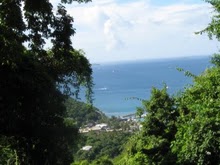On the day that I spotted this flycatcher near the end of September, I had already decided sadly that migration had come to an end for this year. It didn't help that the weather was all cloud and damp, and so my mood was as low as the clouds. I was at the park near my work, staring at the pond, which was completely devoid of all but the fish in the water. With no hope left of sighting waterfowl or any other bird species besides local finches and sparrows, I started walking slowly to work after only a couple of minutes, which meant I had to walk part way around the pond.
That's when I saw a bird dive into some bushes. Naturally, knowing I had the time, I stopped and waited to see if it would fly out and reveal itself. Well it didn't, not at first. It wasn't long before I made up my mind that I had likely just seen one of the finches that inhabit those bushes on a regular basis anyway. With that thought in mind and because of my mood, I started walking abruptly right past the same bushes, only to flush the bird out unintentionally.





















































